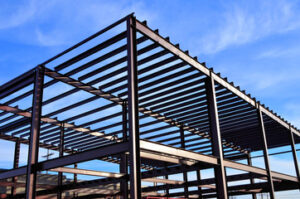Chances are that you’ve used a storage facility or attended an event held in Oklahoma Metal Buildings. These buildings offer a cost-effective solution to space needs and are a great way to add value to your property.

Most people think of these structures as large rectangle floor plans, but they can actually be much more versatile than that. They can also be blast-resistant.
When compared to stick-built construction, metal buildings are usually cheaper to build. However, when budgeting for a new structure, it is essential to consider all upfront and ongoing costs. For example, incorporating energy-efficient features upfront may save money in the long run by reducing utility bills and operating expenses. Additionally, addressing maintenance requirements early on can help prevent costly repairs down the road.
The exact cost of a metal building will depend on the type of structure being constructed and its specifications. For instance, larger structures generally require more materials, which increases the overall expense. The design of the building is also a significant factor in pricing. For instance, clear-span designs require stronger support systems and are more expensive than traditional walled structures. In addition, custom features and customization options can significantly impact the final price tag.
In general, metal buildings are a cost-effective option for projects of all sizes and uses. They are durable and versatile, making them a great choice for warehouses, commercial or industrial spaces, recreational sports facilities, storage units, and garages. Moreover, they are typically less expensive than wood-framed constructions due to their lower material and labor costs.
Once a building is designed, the construction process can begin. Site preparation is crucial for any project, including clearing the area and addressing drainage concerns. It is also important to consider any local regulations or requirements that might affect the construction process. These factors can include zoning regulations, setbacks, and permitting requirements.
Pre-engineered metal buildings are typically made in a factory, which reduces construction time and labor costs. They are also more affordable than other types of construction, and their durability means they can last for decades. In addition, metal is an environmentally responsible building material. It is non-combustible and resists pest infestations and extreme weather conditions.
Once the foundation is prepared, the steel buildings can be delivered to the site and erected. During the erection process, it is essential to follow all safety precautions and ensure that the site is secure. Depending on the size and complexity of the project, it may be necessary to hire professionals to assist with the erection process.
Energy-Efficient
Metal buildings are an energy-efficient option that helps protect the environment. They use recyclable materials and can be recycled at the end of their life cycle, which reduces waste from a landfill. Additionally, they can be insulated with eco-friendly products to maximize energy efficiency and decrease electricity costs.
The steel construction industry is a leader in green building technologies. In fact, a quality prefabricated metal building can qualify for Leadership in Energy and Environmental Design (LEED) certification. When you choose a sustainable metal building, the manufacturer will walk you through design choices, permitting, installation preparations and more to ensure your project is constructed accurately and meets all your desired specifications.
Because of their rigid frame structure, metal buildings have superior insulation capabilities. Their tight seal and reflective roofing help to minimize energy consumption by reducing the amount of heat or cold that enters or escapes the building. This means you can save on utility bills throughout the year.
In addition to minimizing energy usage, the insulation in metal buildings is designed to be flexible and expandable as needs change. This allows you to add more walls or change the shape of a building without having to worry about changing the foundation or making costly upgrades. Additionally, you can choose to install windows in a metal building to allow natural light in and reduce lighting costs throughout the day.
Although metal buildings have a reputation for being less energy efficient than other types of structures, they can be just as energy-efficient when properly maintained. Keeping up with regular maintenance and making sure all penetrations are sealed can significantly improve energy efficiency. In addition, facility managers should know which areas to focus on when looking for ways to increase energy savings such as by addressing air leakage.
Many people are interested in sustainable and environmentally friendly options for their commercial or residential projects. Whether you are looking for an office building, warehouse, or storage space, a steel building is an excellent option. A prefabricated metal building can be customized and erected quickly to minimize your timeline and the impact on your environment.
Versatile
Metal buildings are incredibly versatile and can serve as storage units, garages, or even industrial warehouses. They are also durable and fire-resistant, making them a good choice for businesses like car dealerships or manufacturing plants that need to store inventory or equipment.
These types of structures are a popular choice in the commercial and industrial sectors. Many of these buildings feature large open floor plans to accommodate large machinery or vehicles.
Another way that metal buildings are so versatile is their quick construction process. The pre-engineered components and streamlined assembly process reduce construction timelines, which helps save money on labor costs. These benefits also make them an excellent option for projects that have tight deadlines.
Aesthetically, metal buildings have gained popularity in the recent past due to their sleek design and modern appeal. Architects and engineers have been using metal to challenge traditional architectural norms, creating iconic structures like the Guggenheim Museum in Bilbao.
The versatility of these structures is also evident in their adaptability to homeowners. They can be built to suit a wide range of aesthetic preferences, including an open floor plan or a combination of industrial and cozy elements.
They can also be insulated to improve energy efficiency and provide a comfortable living environment for homeowners. This is a significant benefit as it can help save on utility bills and operational costs over the course of the building’s lifespan.
One of the biggest reasons that people choose a metal building is that they are incredibly cost-effective. Compared to traditional construction, they are less expensive and require significantly less maintenance. In addition, they can be engineered for energy efficiency to help lower operating costs.
Ultimately, a metal building is a great investment for any homeowner or business owner. They can be used as a workshop or storage unit, and their versatility allows them to grow with the owner. They are also an affordable alternative to renting a space, which can save on overhead costs.
If you’re interested in learning more about how a metal building can benefit your home or business, consult with a manufacturer today. They can provide you with quotes and review your options for customization. They can even show you a model of your completed project before the erection process begins.
Environmentally Friendly
Pre-engineered metal buildings are an environmentally friendly construction solution. They are made from recycled and renewable materials, helping to reduce mining waste and pollution. Additionally, they can be easily expanded. This is ideal for warehouses or other facilities that require a large amount of space. In addition, steel buildings can be powered by renewable energy sources such as solar panels and wind turbines. This can help reduce operating costs and offset traditional energy expenses.
The durable nature of a metal building also makes it a good choice for environments that require durability. They are commonly used in industrial applications like refineries, chemical plants, water treatment facilities, factories, and more. Their high strength-to-weight ratio provides superior protection from blasts, fires, and other hazards.
Another advantage of metal buildings is their ability to withstand harsh weather conditions. Their sturdy design helps protect against wind, snow, and ice damage, making them a great choice for areas with extreme temperatures. Additionally, they are resistant to termites and other destructive insects.
One of the best things about steel is that it can be reused in a variety of ways, including being turned into new building materials. Since pre-engineered metal buildings are fabricated to precise specifications, there is very little or no scrap generated during construction. In comparison, traditional building methods produce substantial waste from cutting and shaping wood for each building.
Moreover, many metal building manufacturers use a high percentage of recycled steel in their fabrication processes. This is a major benefit to the environment as it not only saves energy and resources but also contributes to reducing air and water pollution.
A pre-engineered steel building’s impact on the environment is even more impressive when you consider that it can be insulated and integrated with renewable energy. Adding insulation can increase the R-value of your building, thereby reducing energy usage and lowering operational costs over time. Additionally, you can install skylights and dome lights to make the most of natural light.






